Child Study: Physical and Language Development Analysis - Deakin Uni
VerifiedAdded on 2023/06/15

Child study choosing development domain
Name of the Student
Name of the University
Author note
Paraphrase This Document

One learning domains
Physical development in children involves sensory skills by hearing, touching, seeing and
smelling etc. Florida health (2012) described during age 8-12 months infants beg to reach for and
pick up the objects; then try to stand by holding equipments and objects. The infants also
develop their grasp and hand and eye coordination skills that allow them to pick up or throw toys
and objects using their thumb and index finger. I chose two domains, which is physical
development, language, and literacy and my focus child is Declan who is nine months old.
Create safe stimulate environment
VLS (2018) stated that the educators, teachers and the parents must encourage and
support infants to develop their overall physical skills, as every child is different.
During my placement, I acknowledged that environment is part of the curriculum and
physical development directly involve with the environment. Providing safe, positive and
learning environment with age appropriate toys, equipment to the infants help them to develop in
major domains such as physical, cognitive, language, social and emotional as well as in creative
skills. I planned to conduct spontaneous physical activity for my focus child and small group of
infants in the seeds room. These physical activities provided opportunities enhancing Declan’s
fine and gross motor skills, coordination and grasp skills. I provided safe play based learning
experiences including below materials and resource that helped to develop infant’s physical
domain in many ways.
Toddler adventure play spacer/ slide and steps combo

This play space includes different parts such as carpet ramp, mirror ramp, cubby house and
few small steps. The infants had access to explore various obstacles through crawling, stepping,
walking around holding slides and sliding.
Fish and splash water table
I set up this activity for my focus child to explore his sensory skills as well as develop his
hand and eye coordination skills. The infant had endless fun time with the water play like
splashing water with his both hands and catching fish and floating objects. He became familiar
with the materials and the water by seeing, touching developing his imagination skills.
Baby walker and push and pull toys
These play materials and resources improved his gross motor skills through his first steps.
Declan was curious and by second week he was able to stand for around 5 second with support
and begin to walk. Push toys helped Declan to improve his walking skills with my reassurance
and encouraged him to play outdoors.
The Beads frame and wooden blocks, cubes
It develops infant’s fine motor skills through stacking; knocking them and open- ended
learning space for young children to allow develops their imagination skills.
Setting up effective physical environment for young children
Positive learning environment is important where child develops physical competence
and explore the indoor-outdoor space in many ways by making sense of the surrounding (David
and Weinstein 2013).
During my placement, I planned and implemented quality-learning experiences for the
infants with many opportunities to improve their physical skills. Various teaching strategies were
⊘ This is a preview!⊘
Do you want full access?
Subscribe today to unlock all pages.

Trusted by 1+ million students worldwide
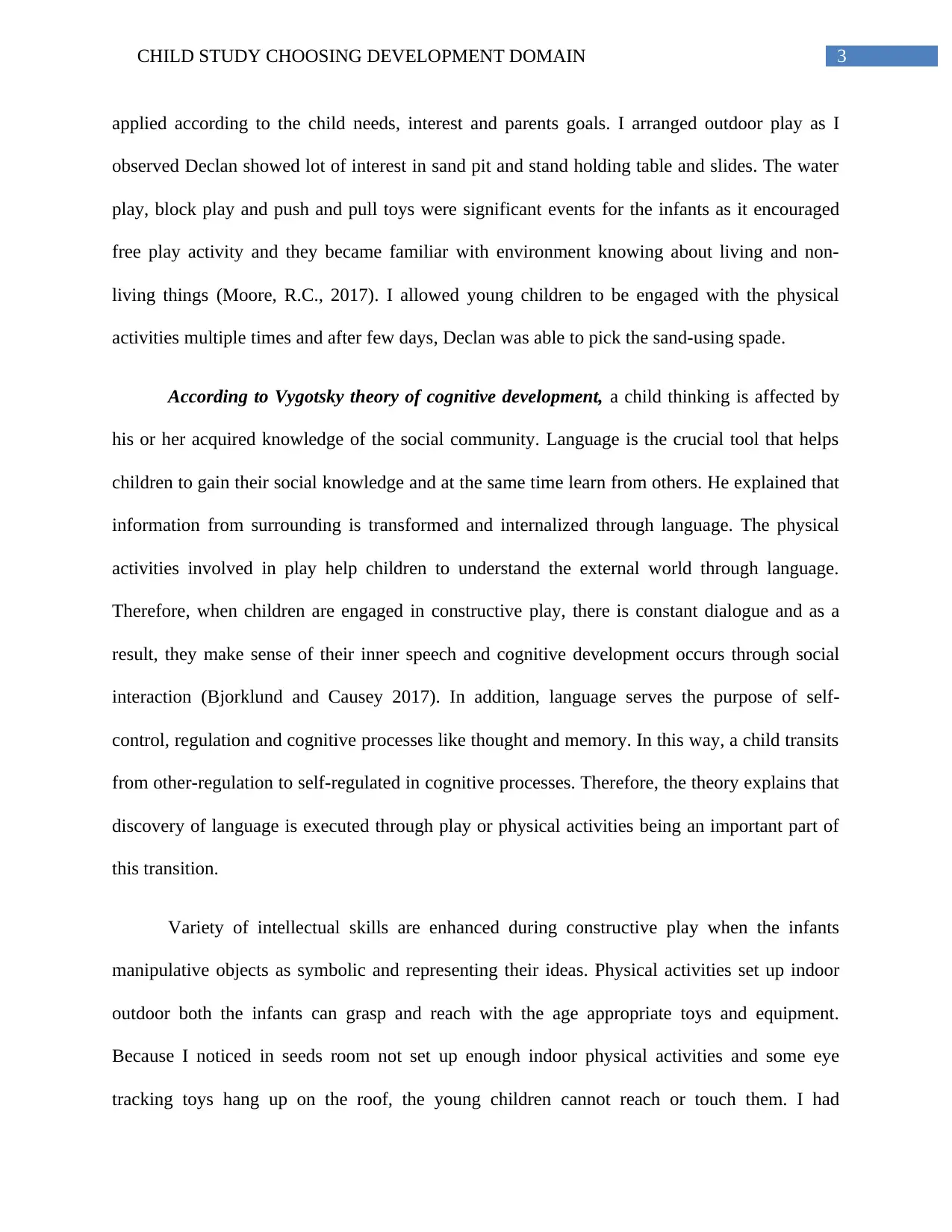
applied according to the child needs, interest and parents goals. I arranged outdoor play as I
observed Declan showed lot of interest in sand pit and stand holding table and slides. The water
play, block play and push and pull toys were significant events for the infants as it encouraged
free play activity and they became familiar with environment knowing about living and non-
living things (Moore, R.C., 2017). I allowed young children to be engaged with the physical
activities multiple times and after few days, Declan was able to pick the sand-using spade.
According to Vygotsky theory of cognitive development, a child thinking is affected by
his or her acquired knowledge of the social community. Language is the crucial tool that helps
children to gain their social knowledge and at the same time learn from others. He explained that
information from surrounding is transformed and internalized through language. The physical
activities involved in play help children to understand the external world through language.
Therefore, when children are engaged in constructive play, there is constant dialogue and as a
result, they make sense of their inner speech and cognitive development occurs through social
interaction (Bjorklund and Causey 2017). In addition, language serves the purpose of self-
control, regulation and cognitive processes like thought and memory. In this way, a child transits
from other-regulation to self-regulated in cognitive processes. Therefore, the theory explains that
discovery of language is executed through play or physical activities being an important part of
this transition.
Variety of intellectual skills are enhanced during constructive play when the infants
manipulative objects as symbolic and representing their ideas. Physical activities set up indoor
outdoor both the infants can grasp and reach with the age appropriate toys and equipment.
Because I noticed in seeds room not set up enough indoor physical activities and some eye
tracking toys hang up on the roof, the young children cannot reach or touch them. I had
Paraphrase This Document
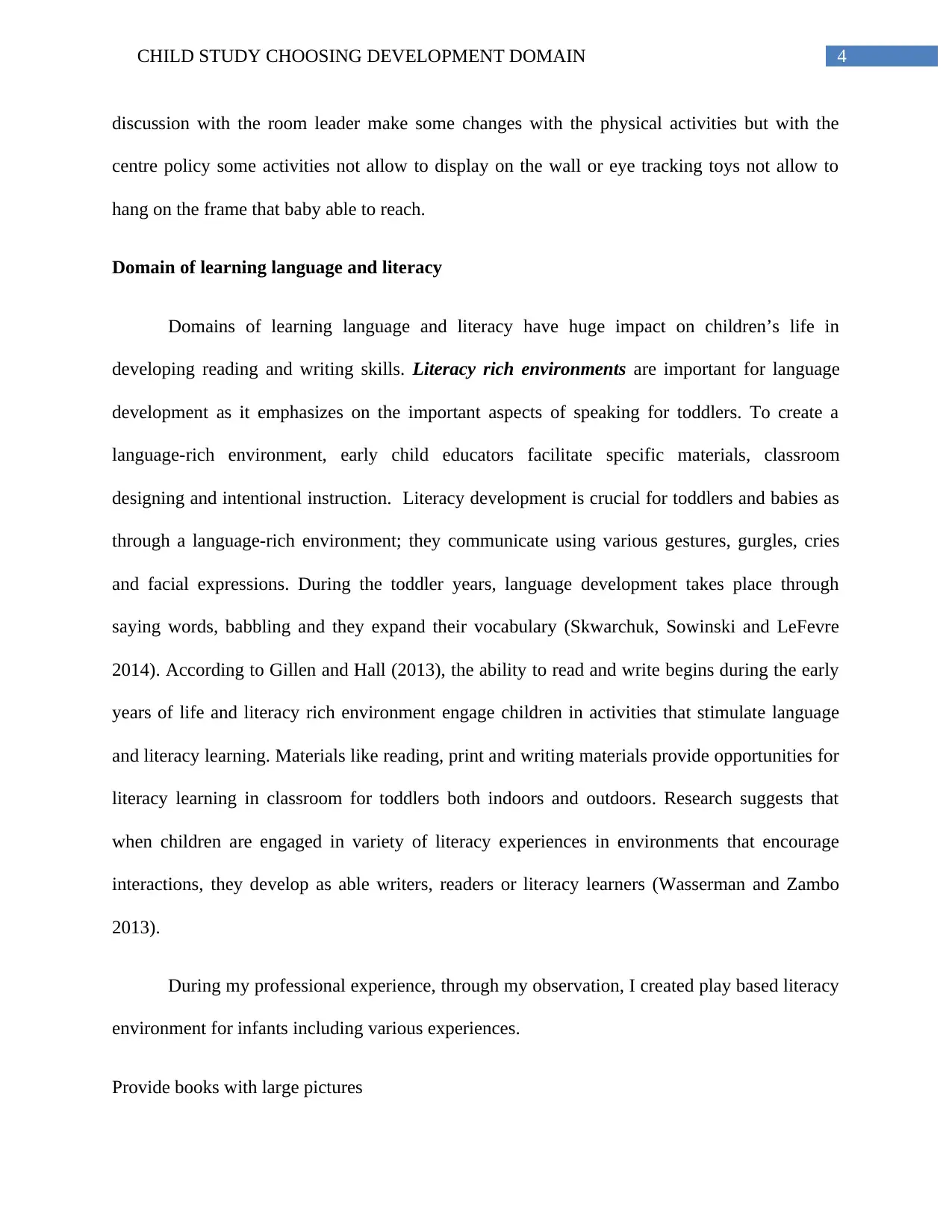
discussion with the room leader make some changes with the physical activities but with the
centre policy some activities not allow to display on the wall or eye tracking toys not allow to
hang on the frame that baby able to reach.
Domain of learning language and literacy
Domains of learning language and literacy have huge impact on children’s life in
developing reading and writing skills. Literacy rich environments are important for language
development as it emphasizes on the important aspects of speaking for toddlers. To create a
language-rich environment, early child educators facilitate specific materials, classroom
designing and intentional instruction. Literacy development is crucial for toddlers and babies as
through a language-rich environment; they communicate using various gestures, gurgles, cries
and facial expressions. During the toddler years, language development takes place through
saying words, babbling and they expand their vocabulary (Skwarchuk, Sowinski and LeFevre
2014). According to Gillen and Hall (2013), the ability to read and write begins during the early
years of life and literacy rich environment engage children in activities that stimulate language
and literacy learning. Materials like reading, print and writing materials provide opportunities for
literacy learning in classroom for toddlers both indoors and outdoors. Research suggests that
when children are engaged in variety of literacy experiences in environments that encourage
interactions, they develop as able writers, readers or literacy learners (Wasserman and Zambo
2013).
During my professional experience, through my observation, I created play based literacy
environment for infants including various experiences.
Provide books with large pictures
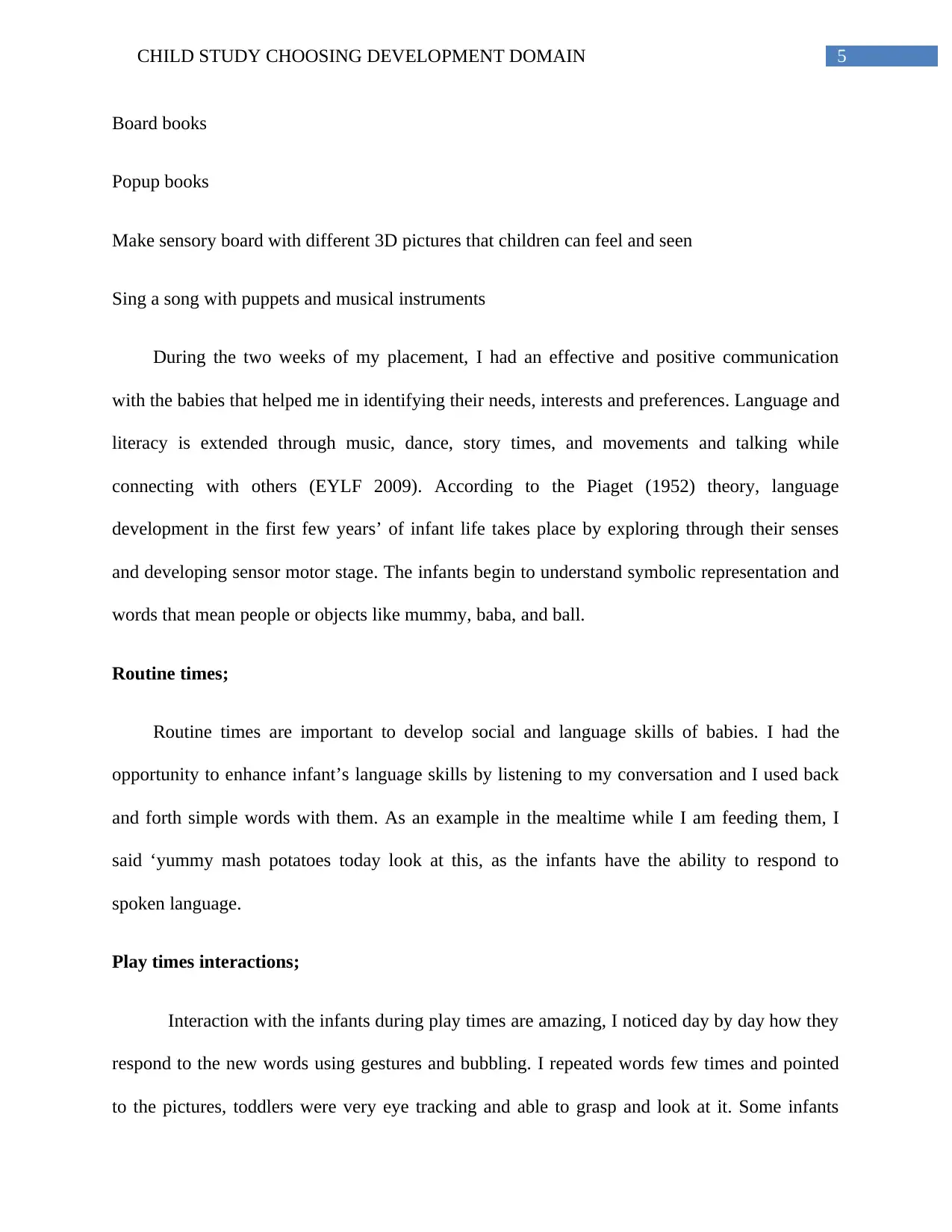
Board books
Popup books
Make sensory board with different 3D pictures that children can feel and seen
Sing a song with puppets and musical instruments
During the two weeks of my placement, I had an effective and positive communication
with the babies that helped me in identifying their needs, interests and preferences. Language and
literacy is extended through music, dance, story times, and movements and talking while
connecting with others (EYLF 2009). According to the Piaget (1952) theory, language
development in the first few years’ of infant life takes place by exploring through their senses
and developing sensor motor stage. The infants begin to understand symbolic representation and
words that mean people or objects like mummy, baba, and ball.
Routine times;
Routine times are important to develop social and language skills of babies. I had the
opportunity to enhance infant’s language skills by listening to my conversation and I used back
and forth simple words with them. As an example in the mealtime while I am feeding them, I
said ‘yummy mash potatoes today look at this, as the infants have the ability to respond to
spoken language.
Play times interactions;
Interaction with the infants during play times are amazing, I noticed day by day how they
respond to the new words using gestures and bubbling. I repeated words few times and pointed
to the pictures, toddlers were very eye tracking and able to grasp and look at it. Some infants
⊘ This is a preview!⊘
Do you want full access?
Subscribe today to unlock all pages.

Trusted by 1+ million students worldwide
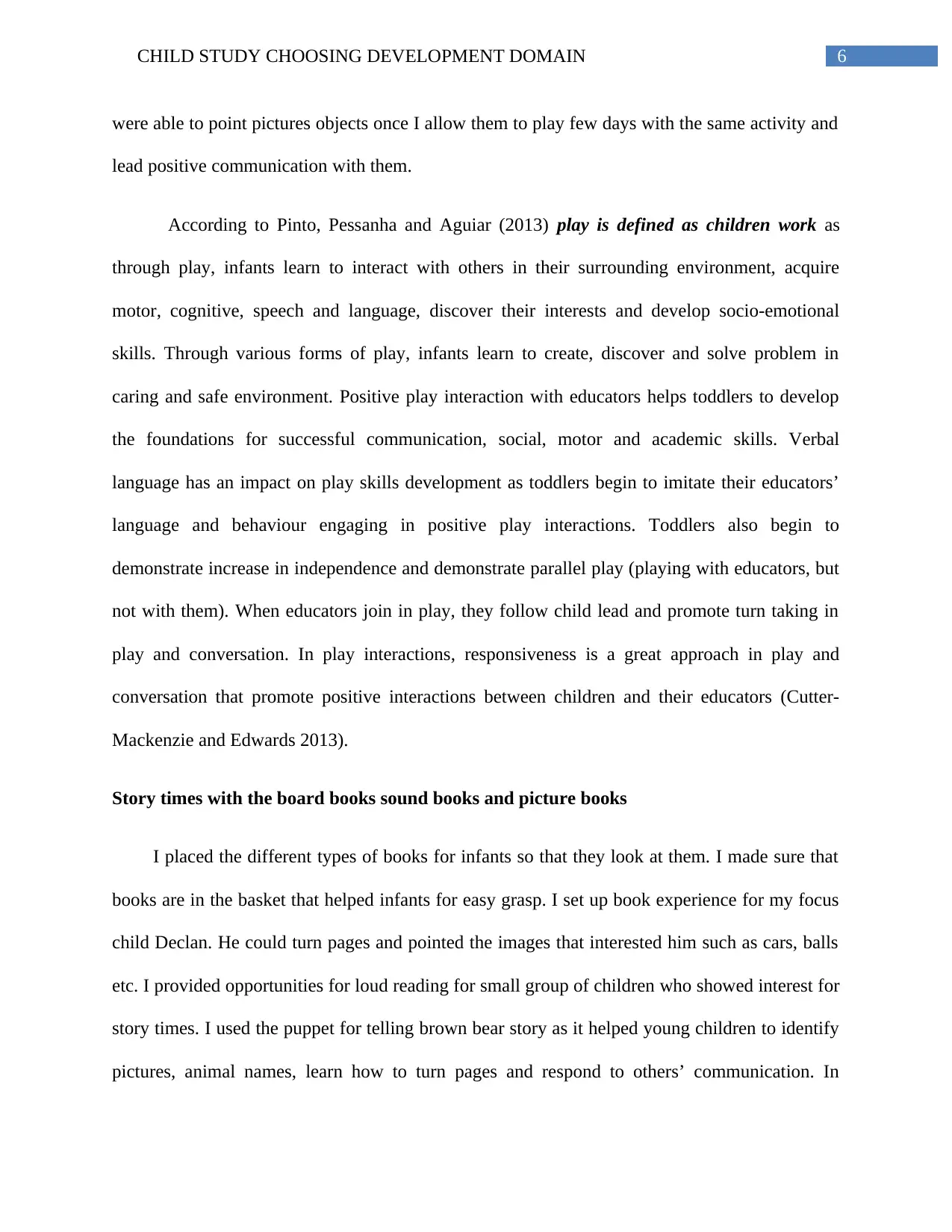
were able to point pictures objects once I allow them to play few days with the same activity and
lead positive communication with them.
According to Pinto, Pessanha and Aguiar (2013) play is defined as children work as
through play, infants learn to interact with others in their surrounding environment, acquire
motor, cognitive, speech and language, discover their interests and develop socio-emotional
skills. Through various forms of play, infants learn to create, discover and solve problem in
caring and safe environment. Positive play interaction with educators helps toddlers to develop
the foundations for successful communication, social, motor and academic skills. Verbal
language has an impact on play skills development as toddlers begin to imitate their educators’
language and behaviour engaging in positive play interactions. Toddlers also begin to
demonstrate increase in independence and demonstrate parallel play (playing with educators, but
not with them). When educators join in play, they follow child lead and promote turn taking in
play and conversation. In play interactions, responsiveness is a great approach in play and
conversation that promote positive interactions between children and their educators (Cutter-
Mackenzie and Edwards 2013).
Story times with the board books sound books and picture books
I placed the different types of books for infants so that they look at them. I made sure that
books are in the basket that helped infants for easy grasp. I set up book experience for my focus
child Declan. He could turn pages and pointed the images that interested him such as cars, balls
etc. I provided opportunities for loud reading for small group of children who showed interest for
story times. I used the puppet for telling brown bear story as it helped young children to identify
pictures, animal names, learn how to turn pages and respond to others’ communication. In
Paraphrase This Document
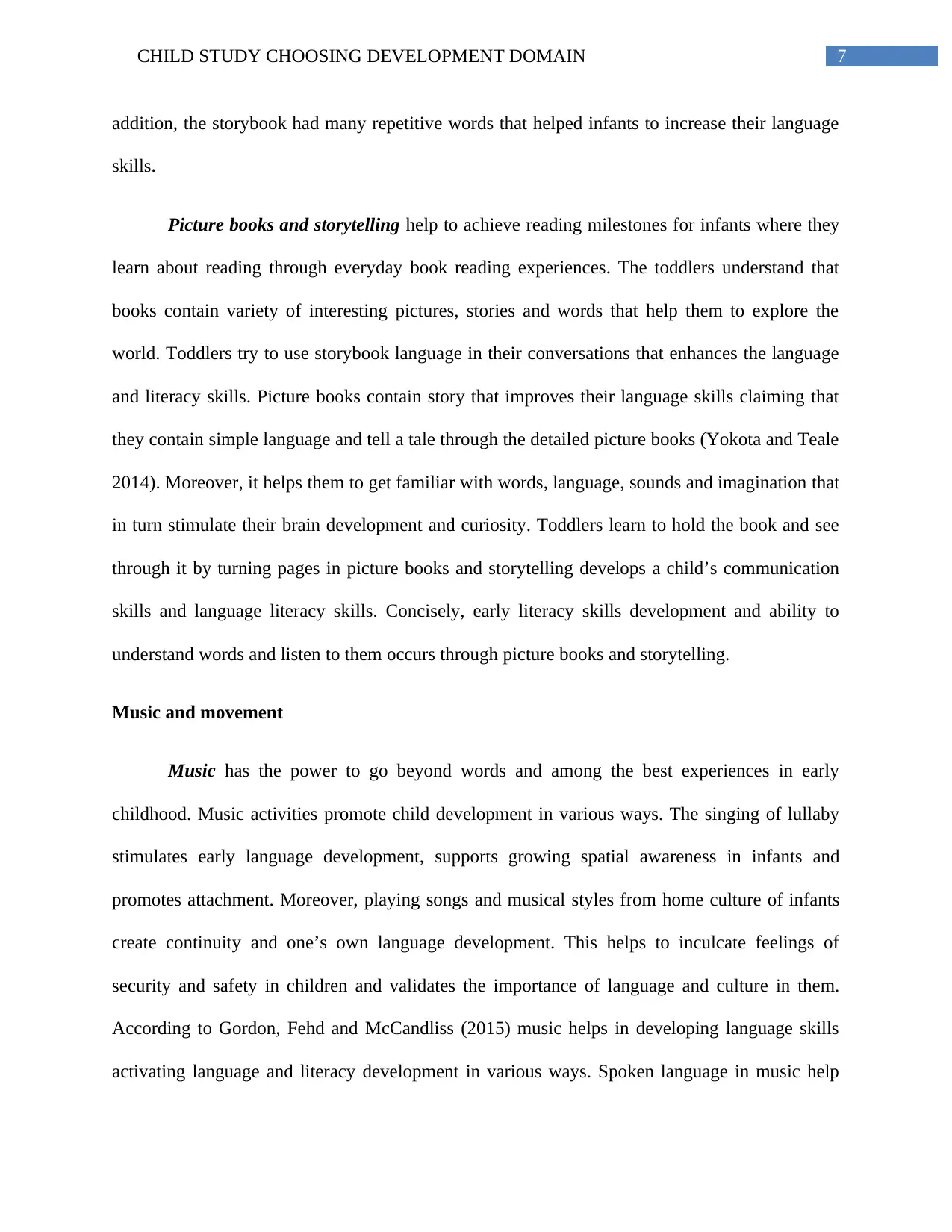
addition, the storybook had many repetitive words that helped infants to increase their language
skills.
Picture books and storytelling help to achieve reading milestones for infants where they
learn about reading through everyday book reading experiences. The toddlers understand that
books contain variety of interesting pictures, stories and words that help them to explore the
world. Toddlers try to use storybook language in their conversations that enhances the language
and literacy skills. Picture books contain story that improves their language skills claiming that
they contain simple language and tell a tale through the detailed picture books (Yokota and Teale
2014). Moreover, it helps them to get familiar with words, language, sounds and imagination that
in turn stimulate their brain development and curiosity. Toddlers learn to hold the book and see
through it by turning pages in picture books and storytelling develops a child’s communication
skills and language literacy skills. Concisely, early literacy skills development and ability to
understand words and listen to them occurs through picture books and storytelling.
Music and movement
Music has the power to go beyond words and among the best experiences in early
childhood. Music activities promote child development in various ways. The singing of lullaby
stimulates early language development, supports growing spatial awareness in infants and
promotes attachment. Moreover, playing songs and musical styles from home culture of infants
create continuity and one’s own language development. This helps to inculcate feelings of
security and safety in children and validates the importance of language and culture in them.
According to Gordon, Fehd and McCandliss (2015) music helps in developing language skills
activating language and literacy development in various ways. Spoken language in music help
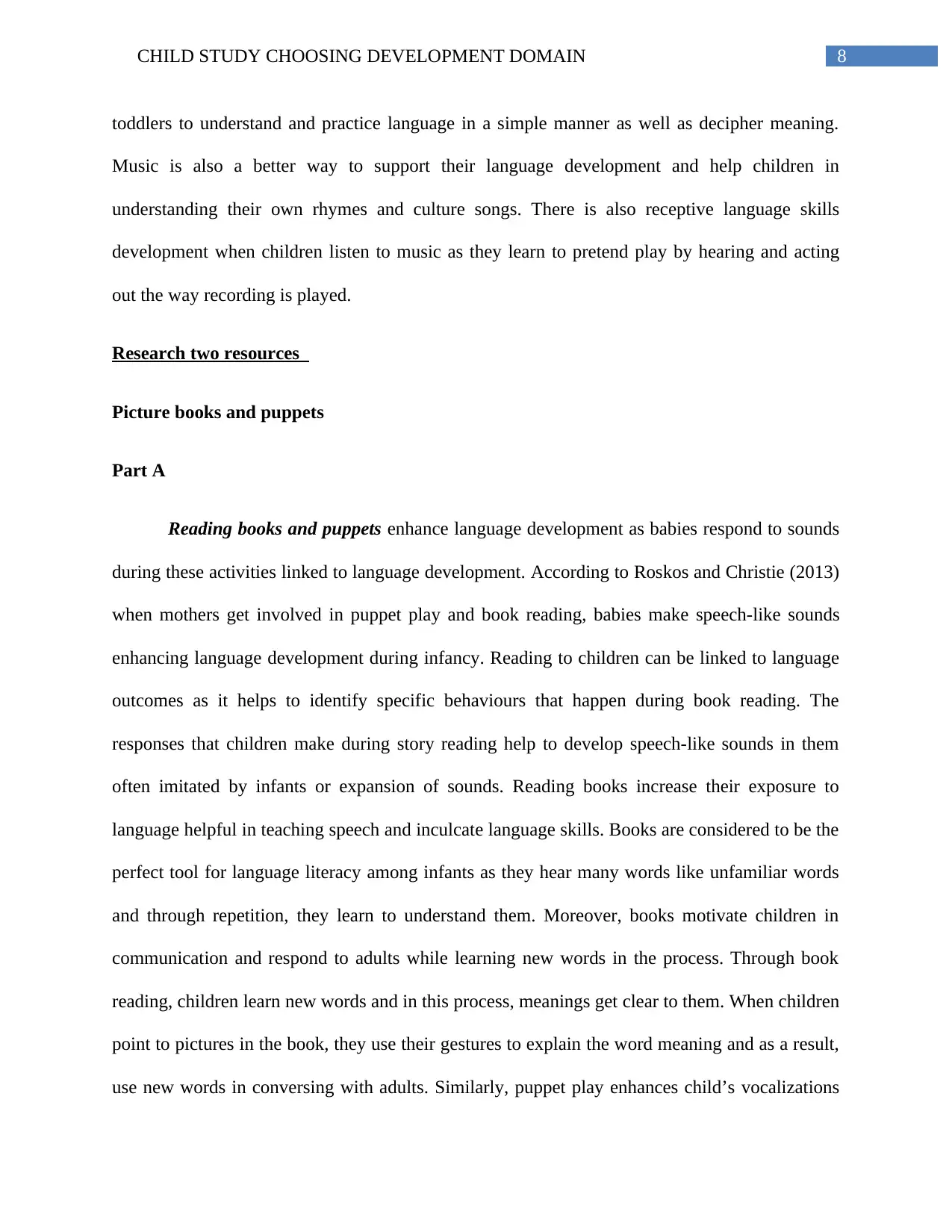
toddlers to understand and practice language in a simple manner as well as decipher meaning.
Music is also a better way to support their language development and help children in
understanding their own rhymes and culture songs. There is also receptive language skills
development when children listen to music as they learn to pretend play by hearing and acting
out the way recording is played.
Research two resources
Picture books and puppets
Part A
Reading books and puppets enhance language development as babies respond to sounds
during these activities linked to language development. According to Roskos and Christie (2013)
when mothers get involved in puppet play and book reading, babies make speech-like sounds
enhancing language development during infancy. Reading to children can be linked to language
outcomes as it helps to identify specific behaviours that happen during book reading. The
responses that children make during story reading help to develop speech-like sounds in them
often imitated by infants or expansion of sounds. Reading books increase their exposure to
language helpful in teaching speech and inculcate language skills. Books are considered to be the
perfect tool for language literacy among infants as they hear many words like unfamiliar words
and through repetition, they learn to understand them. Moreover, books motivate children in
communication and respond to adults while learning new words in the process. Through book
reading, children learn new words and in this process, meanings get clear to them. When children
point to pictures in the book, they use their gestures to explain the word meaning and as a result,
use new words in conversing with adults. Similarly, puppet play enhances child’s vocalizations
⊘ This is a preview!⊘
Do you want full access?
Subscribe today to unlock all pages.

Trusted by 1+ million students worldwide
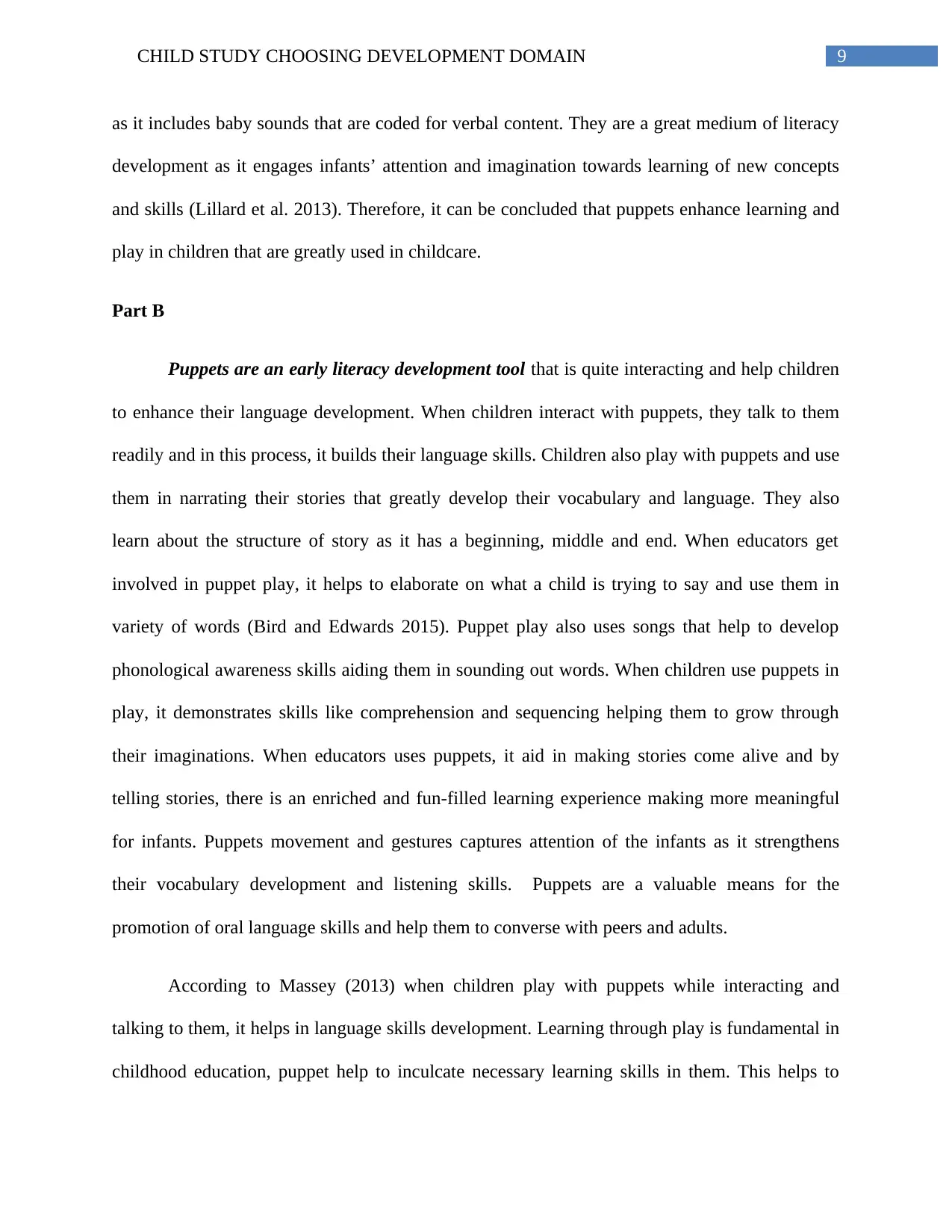
as it includes baby sounds that are coded for verbal content. They are a great medium of literacy
development as it engages infants’ attention and imagination towards learning of new concepts
and skills (Lillard et al. 2013). Therefore, it can be concluded that puppets enhance learning and
play in children that are greatly used in childcare.
Part B
Puppets are an early literacy development tool that is quite interacting and help children
to enhance their language development. When children interact with puppets, they talk to them
readily and in this process, it builds their language skills. Children also play with puppets and use
them in narrating their stories that greatly develop their vocabulary and language. They also
learn about the structure of story as it has a beginning, middle and end. When educators get
involved in puppet play, it helps to elaborate on what a child is trying to say and use them in
variety of words (Bird and Edwards 2015). Puppet play also uses songs that help to develop
phonological awareness skills aiding them in sounding out words. When children use puppets in
play, it demonstrates skills like comprehension and sequencing helping them to grow through
their imaginations. When educators uses puppets, it aid in making stories come alive and by
telling stories, there is an enriched and fun-filled learning experience making more meaningful
for infants. Puppets movement and gestures captures attention of the infants as it strengthens
their vocabulary development and listening skills. Puppets are a valuable means for the
promotion of oral language skills and help them to converse with peers and adults.
According to Massey (2013) when children play with puppets while interacting and
talking to them, it helps in language skills development. Learning through play is fundamental in
childhood education, puppet help to inculcate necessary learning skills in them. This helps to
Paraphrase This Document

encourage creative discovery and play and stimulate imagination-working wonders for socio-
emotional, language, physical and cognitive development. For many children, puppet play helps
to open up a new medium of communication that supports acquisition of learning skills. Puppets
are also used as therapeutic purposes for educators in early childhood education as it greatly
supports language development and communication skills in infants and toddlers. Moreover,
when children play with puppets, they learn to converse, acquire new word learning, formulate
thoughts and are able to convey their message efficiently. The effective way to develop language
skills in infants is role-play in puppets to model oral language. Adults become responsive and get
involved with infants encourages correct sentence structure and introduces new vocabulary
language into conversation. Infants get captivated with the colourful puppet animals and small
people taking them into their own imagination and representing a humorous and safe look at the
world (Lillard et al. 2013). Therefore, puppets are a safe way for educators to help infants
develop their literacy skills and enhance language development.
Push and pull toys and baby walker, building blocks
Push and pull toys for play is important for physical development in infants. They
greatly enhance their motor skills as toys can be manipulated wither by pulling or pushing.
Moreover, push or pull play help to develop fine and gross motor skills as children use their
hands for gripping the handle as they pull or push or grasp the pull. This greatly strengthens their
arms and legs muscles as they play with the toy. These toys greatly foster creative play and
independent learning as infants learns to toddle and pull off their toys on a lead. They learn to
navigate the obstacles that they encounter while playing with it. This toy also offers physical
challenge to the children, as they have to stand, hold the push-along toy and later walk as they
push through it (Newson and Newson 2017). This is a milestone for the infants as they learn
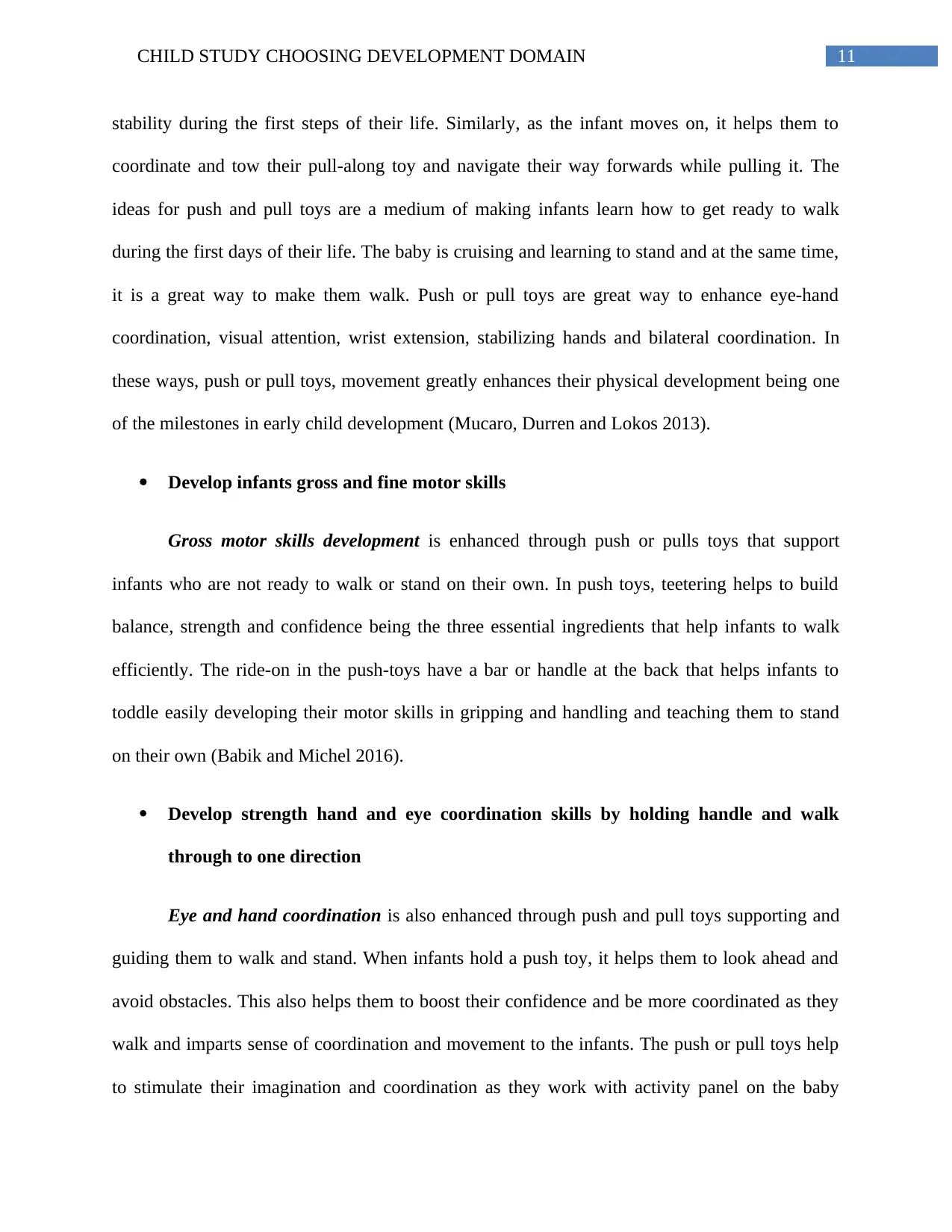
stability during the first steps of their life. Similarly, as the infant moves on, it helps them to
coordinate and tow their pull-along toy and navigate their way forwards while pulling it. The
ideas for push and pull toys are a medium of making infants learn how to get ready to walk
during the first days of their life. The baby is cruising and learning to stand and at the same time,
it is a great way to make them walk. Push or pull toys are great way to enhance eye-hand
coordination, visual attention, wrist extension, stabilizing hands and bilateral coordination. In
these ways, push or pull toys, movement greatly enhances their physical development being one
of the milestones in early child development (Mucaro, Durren and Lokos 2013).
Develop infants gross and fine motor skills
Gross motor skills development is enhanced through push or pulls toys that support
infants who are not ready to walk or stand on their own. In push toys, teetering helps to build
balance, strength and confidence being the three essential ingredients that help infants to walk
efficiently. The ride-on in the push-toys have a bar or handle at the back that helps infants to
toddle easily developing their motor skills in gripping and handling and teaching them to stand
on their own (Babik and Michel 2016).
Develop strength hand and eye coordination skills by holding handle and walk
through to one direction
Eye and hand coordination is also enhanced through push and pull toys supporting and
guiding them to walk and stand. When infants hold a push toy, it helps them to look ahead and
avoid obstacles. This also helps them to boost their confidence and be more coordinated as they
walk and imparts sense of coordination and movement to the infants. The push or pull toys help
to stimulate their imagination and coordination as they work with activity panel on the baby
⊘ This is a preview!⊘
Do you want full access?
Subscribe today to unlock all pages.

Trusted by 1+ million students worldwide
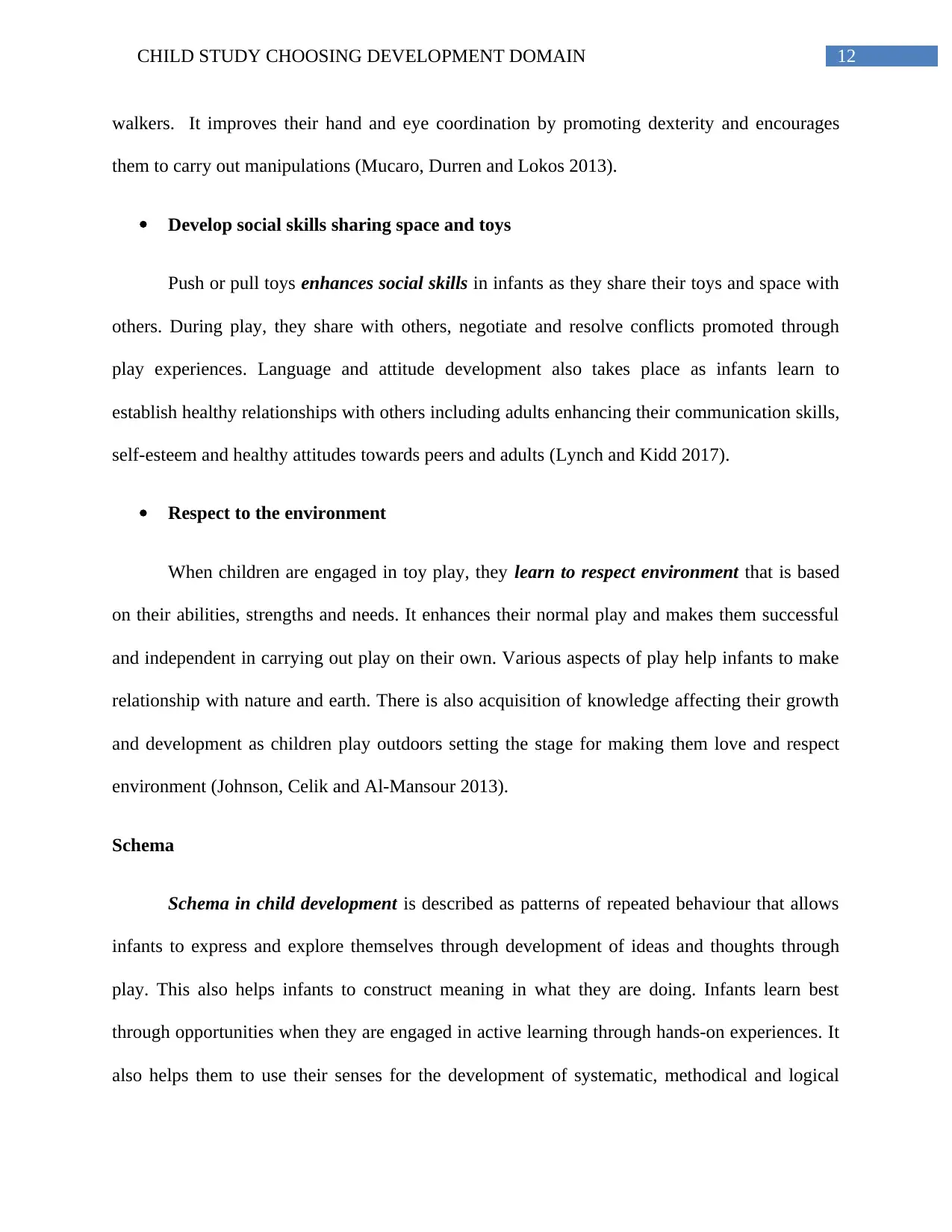
walkers. It improves their hand and eye coordination by promoting dexterity and encourages
them to carry out manipulations (Mucaro, Durren and Lokos 2013).
Develop social skills sharing space and toys
Push or pull toys enhances social skills in infants as they share their toys and space with
others. During play, they share with others, negotiate and resolve conflicts promoted through
play experiences. Language and attitude development also takes place as infants learn to
establish healthy relationships with others including adults enhancing their communication skills,
self-esteem and healthy attitudes towards peers and adults (Lynch and Kidd 2017).
Respect to the environment
When children are engaged in toy play, they learn to respect environment that is based
on their abilities, strengths and needs. It enhances their normal play and makes them successful
and independent in carrying out play on their own. Various aspects of play help infants to make
relationship with nature and earth. There is also acquisition of knowledge affecting their growth
and development as children play outdoors setting the stage for making them love and respect
environment (Johnson, Celik and Al-Mansour 2013).
Schema
Schema in child development is described as patterns of repeated behaviour that allows
infants to express and explore themselves through development of ideas and thoughts through
play. This also helps infants to construct meaning in what they are doing. Infants learn best
through opportunities when they are engaged in active learning through hands-on experiences. It
also helps them to use their senses for the development of systematic, methodical and logical
Paraphrase This Document
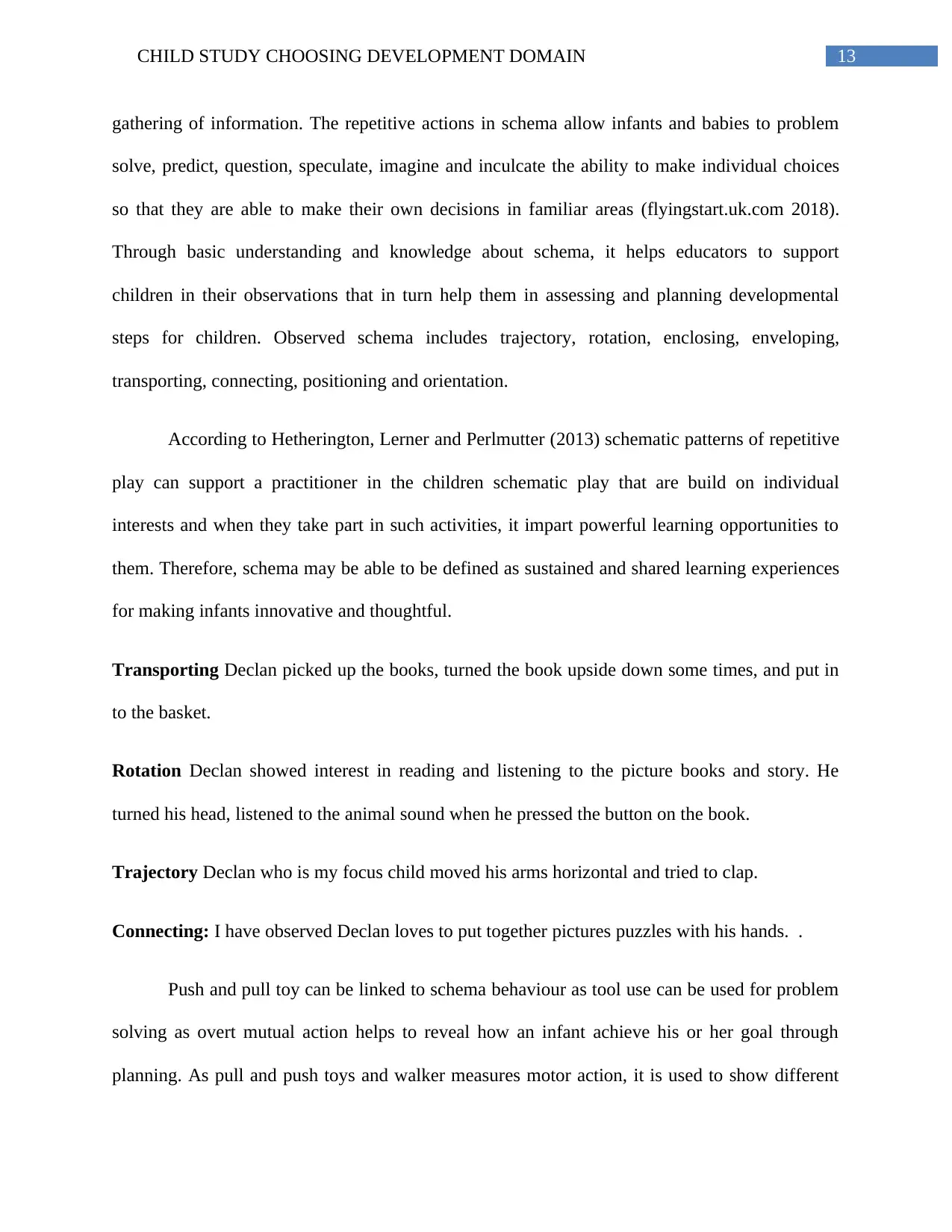
gathering of information. The repetitive actions in schema allow infants and babies to problem
solve, predict, question, speculate, imagine and inculcate the ability to make individual choices
so that they are able to make their own decisions in familiar areas (flyingstart.uk.com 2018).
Through basic understanding and knowledge about schema, it helps educators to support
children in their observations that in turn help them in assessing and planning developmental
steps for children. Observed schema includes trajectory, rotation, enclosing, enveloping,
transporting, connecting, positioning and orientation.
According to Hetherington, Lerner and Perlmutter (2013) schematic patterns of repetitive
play can support a practitioner in the children schematic play that are build on individual
interests and when they take part in such activities, it impart powerful learning opportunities to
them. Therefore, schema may be able to be defined as sustained and shared learning experiences
for making infants innovative and thoughtful.
Transporting Declan picked up the books, turned the book upside down some times, and put in
to the basket.
Rotation Declan showed interest in reading and listening to the picture books and story. He
turned his head, listened to the animal sound when he pressed the button on the book.
Trajectory Declan who is my focus child moved his arms horizontal and tried to clap.
Connecting: I have observed Declan loves to put together pictures puzzles with his hands. .
Push and pull toy can be linked to schema behaviour as tool use can be used for problem
solving as overt mutual action helps to reveal how an infant achieve his or her goal through
planning. As pull and push toys and walker measures motor action, it is used to show different
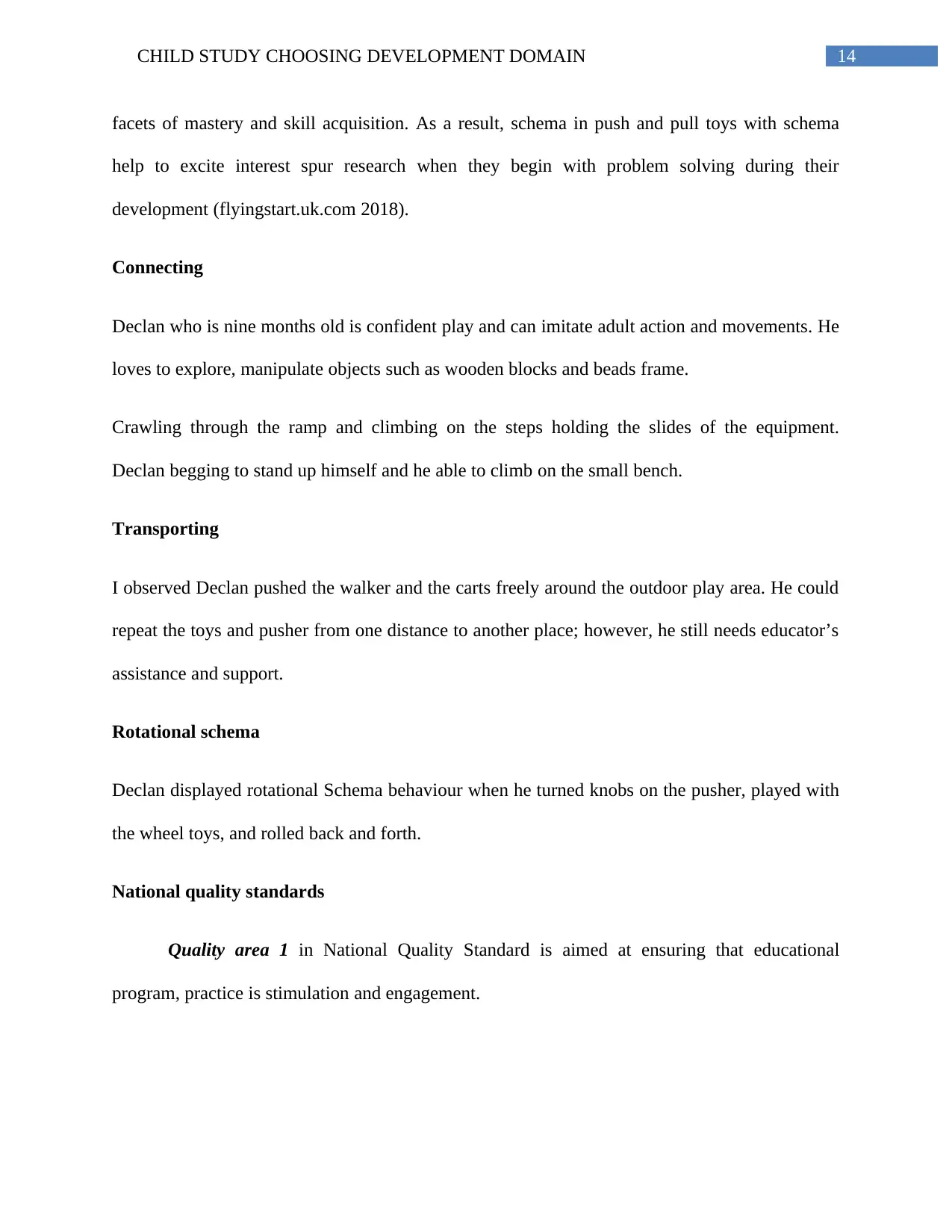
facets of mastery and skill acquisition. As a result, schema in push and pull toys with schema
help to excite interest spur research when they begin with problem solving during their
development (flyingstart.uk.com 2018).
Connecting
Declan who is nine months old is confident play and can imitate adult action and movements. He
loves to explore, manipulate objects such as wooden blocks and beads frame.
Crawling through the ramp and climbing on the steps holding the slides of the equipment.
Declan begging to stand up himself and he able to climb on the small bench.
Transporting
I observed Declan pushed the walker and the carts freely around the outdoor play area. He could
repeat the toys and pusher from one distance to another place; however, he still needs educator’s
assistance and support.
Rotational schema
Declan displayed rotational Schema behaviour when he turned knobs on the pusher, played with
the wheel toys, and rolled back and forth.
National quality standards
Quality area 1 in National Quality Standard is aimed at ensuring that educational
program, practice is stimulation and engagement.
⊘ This is a preview!⊘
Do you want full access?
Subscribe today to unlock all pages.

Trusted by 1+ million students worldwide
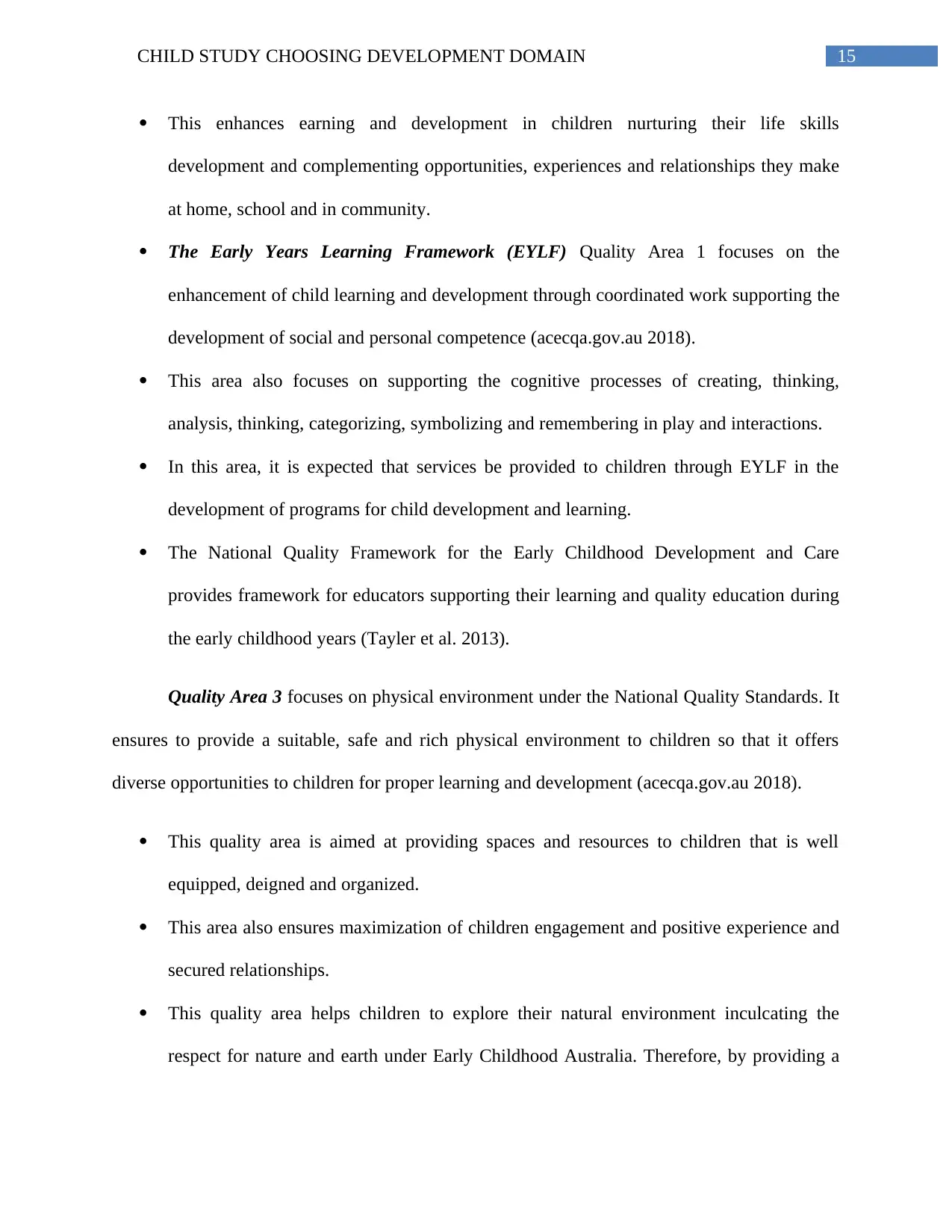
This enhances earning and development in children nurturing their life skills
development and complementing opportunities, experiences and relationships they make
at home, school and in community.
The Early Years Learning Framework (EYLF) Quality Area 1 focuses on the
enhancement of child learning and development through coordinated work supporting the
development of social and personal competence (acecqa.gov.au 2018).
This area also focuses on supporting the cognitive processes of creating, thinking,
analysis, thinking, categorizing, symbolizing and remembering in play and interactions.
In this area, it is expected that services be provided to children through EYLF in the
development of programs for child development and learning.
The National Quality Framework for the Early Childhood Development and Care
provides framework for educators supporting their learning and quality education during
the early childhood years (Tayler et al. 2013).
Quality Area 3 focuses on physical environment under the National Quality Standards. It
ensures to provide a suitable, safe and rich physical environment to children so that it offers
diverse opportunities to children for proper learning and development (acecqa.gov.au 2018).
This quality area is aimed at providing spaces and resources to children that is well
equipped, deigned and organized.
This area also ensures maximization of children engagement and positive experience and
secured relationships.
This quality area helps children to explore their natural environment inculcating the
respect for nature and earth under Early Childhood Australia. Therefore, by providing a
Paraphrase This Document
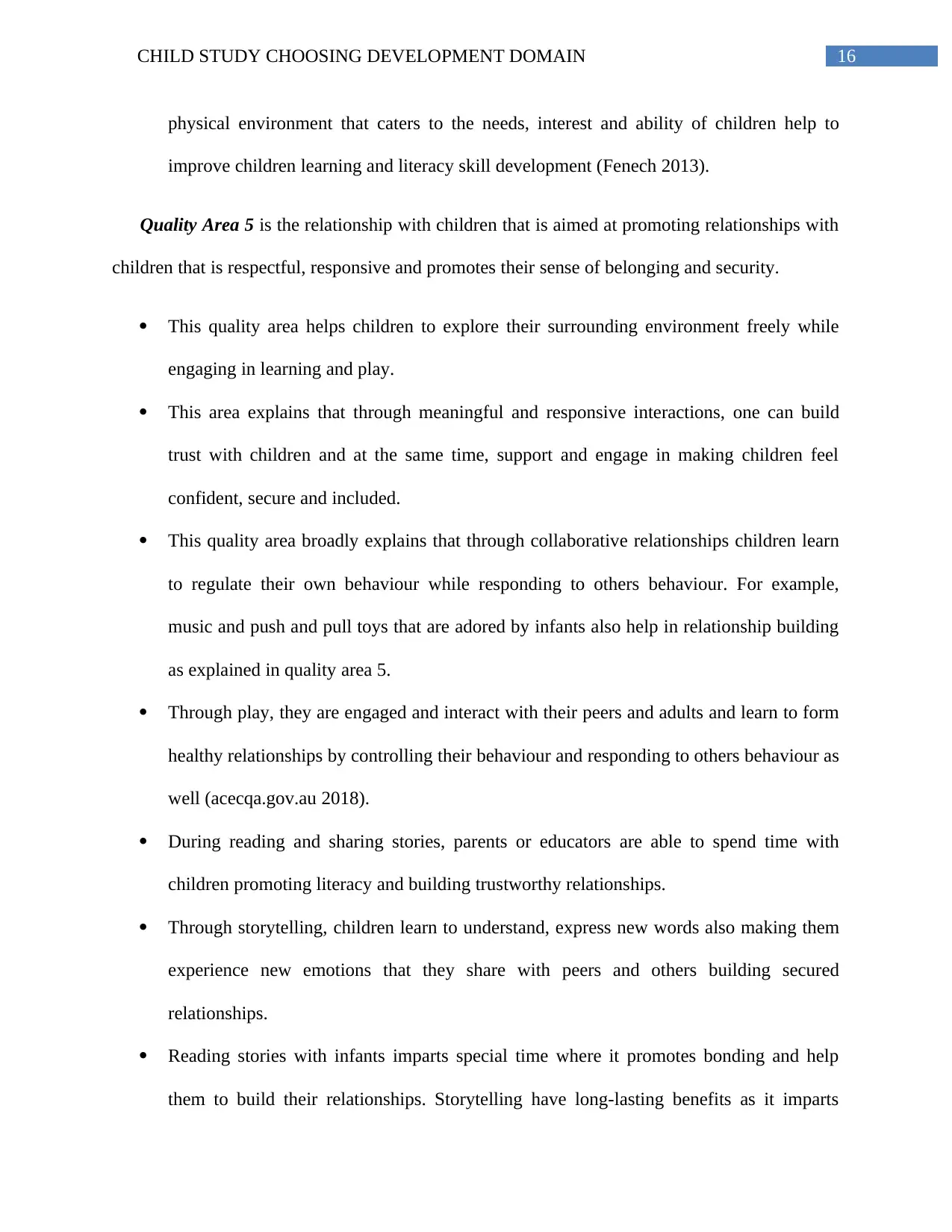
physical environment that caters to the needs, interest and ability of children help to
improve children learning and literacy skill development (Fenech 2013).
Quality Area 5 is the relationship with children that is aimed at promoting relationships with
children that is respectful, responsive and promotes their sense of belonging and security.
This quality area helps children to explore their surrounding environment freely while
engaging in learning and play.
This area explains that through meaningful and responsive interactions, one can build
trust with children and at the same time, support and engage in making children feel
confident, secure and included.
This quality area broadly explains that through collaborative relationships children learn
to regulate their own behaviour while responding to others behaviour. For example,
music and push and pull toys that are adored by infants also help in relationship building
as explained in quality area 5.
Through play, they are engaged and interact with their peers and adults and learn to form
healthy relationships by controlling their behaviour and responding to others behaviour as
well (acecqa.gov.au 2018).
During reading and sharing stories, parents or educators are able to spend time with
children promoting literacy and building trustworthy relationships.
Through storytelling, children learn to understand, express new words also making them
experience new emotions that they share with peers and others building secured
relationships.
Reading stories with infants imparts special time where it promotes bonding and help
them to build their relationships. Storytelling have long-lasting benefits as it imparts
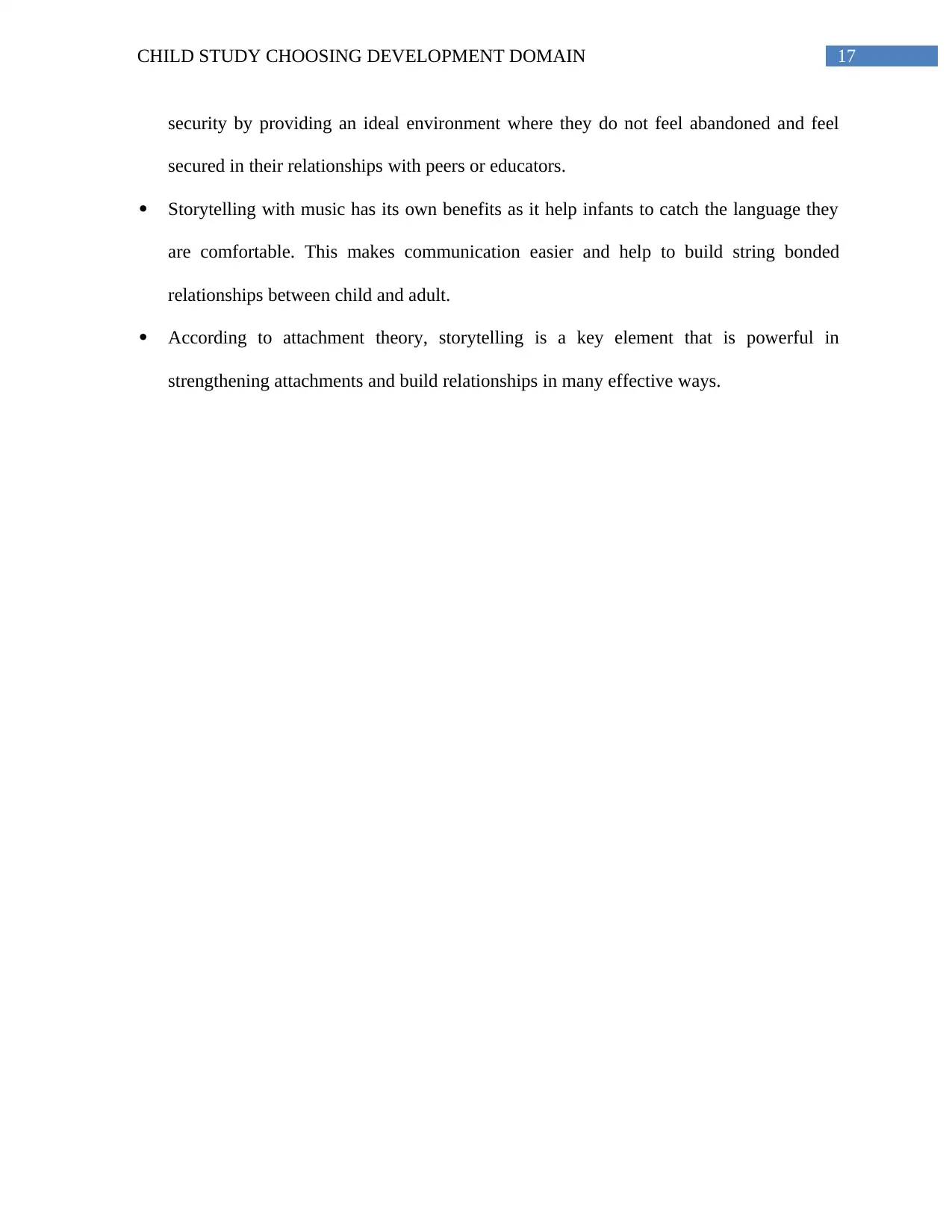
security by providing an ideal environment where they do not feel abandoned and feel
secured in their relationships with peers or educators.
Storytelling with music has its own benefits as it help infants to catch the language they
are comfortable. This makes communication easier and help to build string bonded
relationships between child and adult.
According to attachment theory, storytelling is a key element that is powerful in
strengthening attachments and build relationships in many effective ways.
⊘ This is a preview!⊘
Do you want full access?
Subscribe today to unlock all pages.

Trusted by 1+ million students worldwide
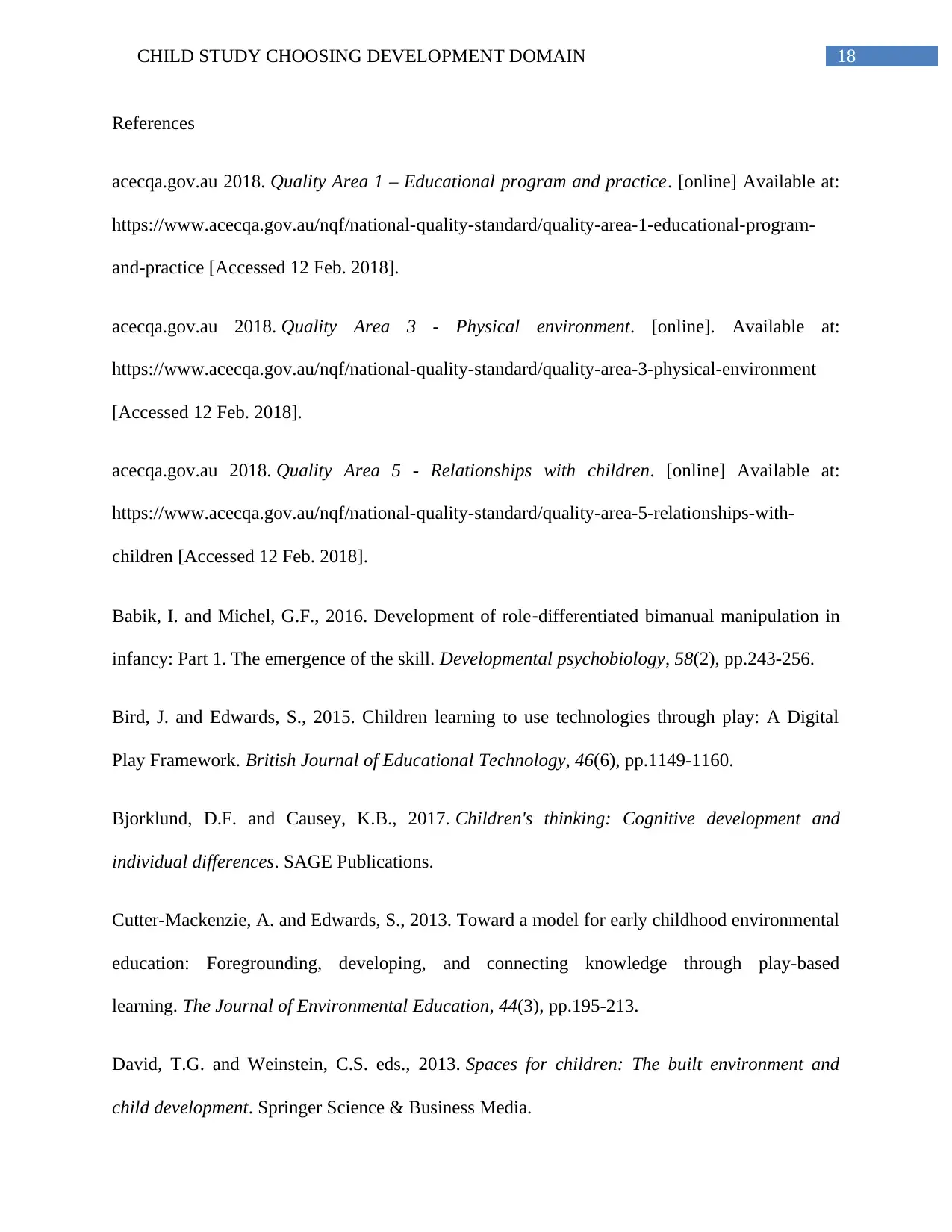
References
acecqa.gov.au 2018. Quality Area 1 – Educational program and practice. [online] Available at:
https://www.acecqa.gov.au/nqf/national-quality-standard/quality-area-1-educational-program-
and-practice [Accessed 12 Feb. 2018].
acecqa.gov.au 2018. Quality Area 3 - Physical environment. [online]. Available at:
https://www.acecqa.gov.au/nqf/national-quality-standard/quality-area-3-physical-environment
[Accessed 12 Feb. 2018].
acecqa.gov.au 2018. Quality Area 5 - Relationships with children. [online] Available at:
https://www.acecqa.gov.au/nqf/national-quality-standard/quality-area-5-relationships-with-
children [Accessed 12 Feb. 2018].
Babik, I. and Michel, G.F., 2016. Development of role‐differentiated bimanual manipulation in
infancy: Part 1. The emergence of the skill. Developmental psychobiology, 58(2), pp.243-256.
Bird, J. and Edwards, S., 2015. Children learning to use technologies through play: A Digital
Play Framework. British Journal of Educational Technology, 46(6), pp.1149-1160.
Bjorklund, D.F. and Causey, K.B., 2017. Children's thinking: Cognitive development and
individual differences. SAGE Publications.
Cutter-Mackenzie, A. and Edwards, S., 2013. Toward a model for early childhood environmental
education: Foregrounding, developing, and connecting knowledge through play-based
learning. The Journal of Environmental Education, 44(3), pp.195-213.
David, T.G. and Weinstein, C.S. eds., 2013. Spaces for children: The built environment and
child development. Springer Science & Business Media.
Paraphrase This Document
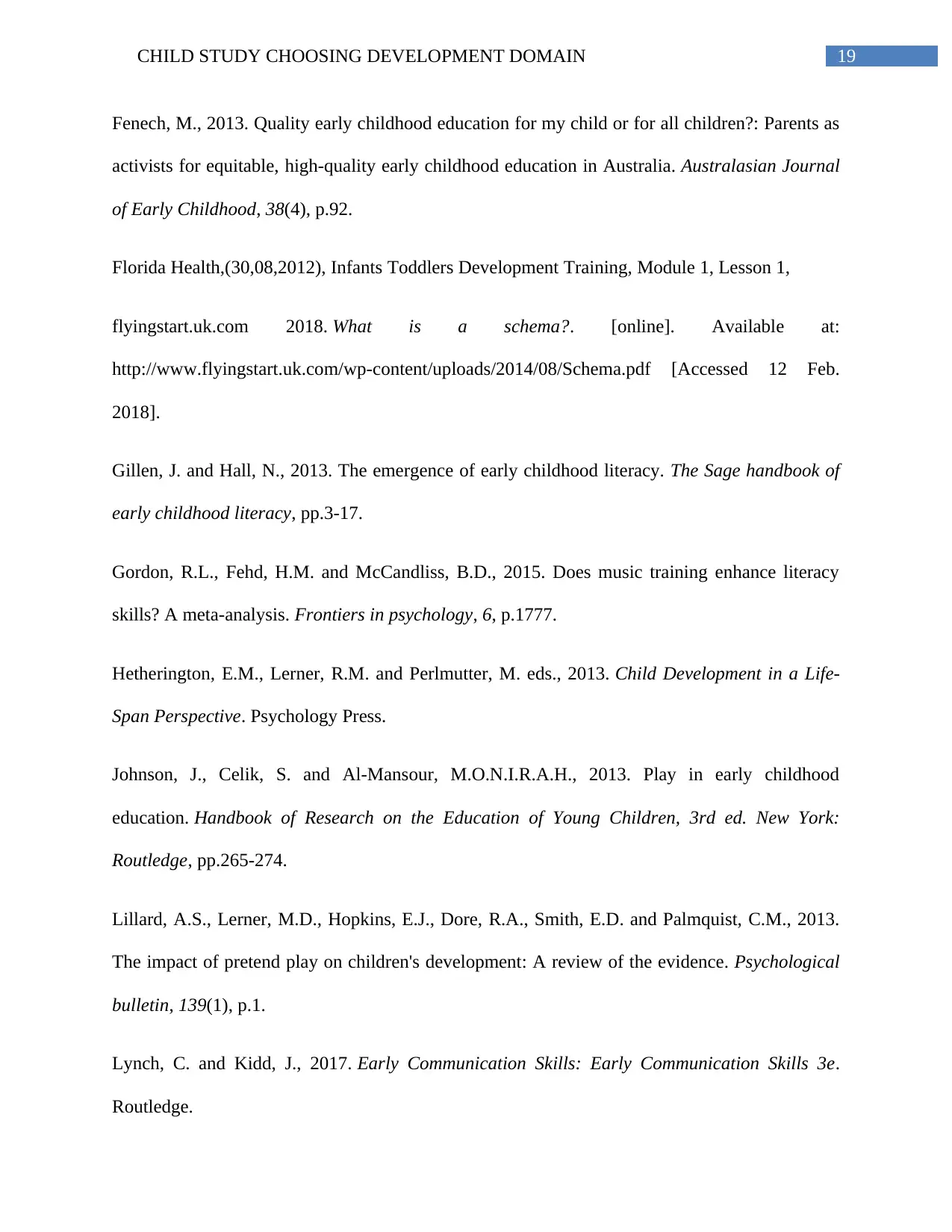
Fenech, M., 2013. Quality early childhood education for my child or for all children?: Parents as
activists for equitable, high-quality early childhood education in Australia. Australasian Journal
of Early Childhood, 38(4), p.92.
Florida Health,(30,08,2012), Infants Toddlers Development Training, Module 1, Lesson 1,
flyingstart.uk.com 2018. What is a schema?. [online]. Available at:
http://www.flyingstart.uk.com/wp-content/uploads/2014/08/Schema.pdf [Accessed 12 Feb.
2018].
Gillen, J. and Hall, N., 2013. The emergence of early childhood literacy. The Sage handbook of
early childhood literacy, pp.3-17.
Gordon, R.L., Fehd, H.M. and McCandliss, B.D., 2015. Does music training enhance literacy
skills? A meta-analysis. Frontiers in psychology, 6, p.1777.
Hetherington, E.M., Lerner, R.M. and Perlmutter, M. eds., 2013. Child Development in a Life-
Span Perspective. Psychology Press.
Johnson, J., Celik, S. and Al-Mansour, M.O.N.I.R.A.H., 2013. Play in early childhood
education. Handbook of Research on the Education of Young Children, 3rd ed. New York:
Routledge, pp.265-274.
Lillard, A.S., Lerner, M.D., Hopkins, E.J., Dore, R.A., Smith, E.D. and Palmquist, C.M., 2013.
The impact of pretend play on children's development: A review of the evidence. Psychological
bulletin, 139(1), p.1.
Lynch, C. and Kidd, J., 2017. Early Communication Skills: Early Communication Skills 3e.
Routledge.
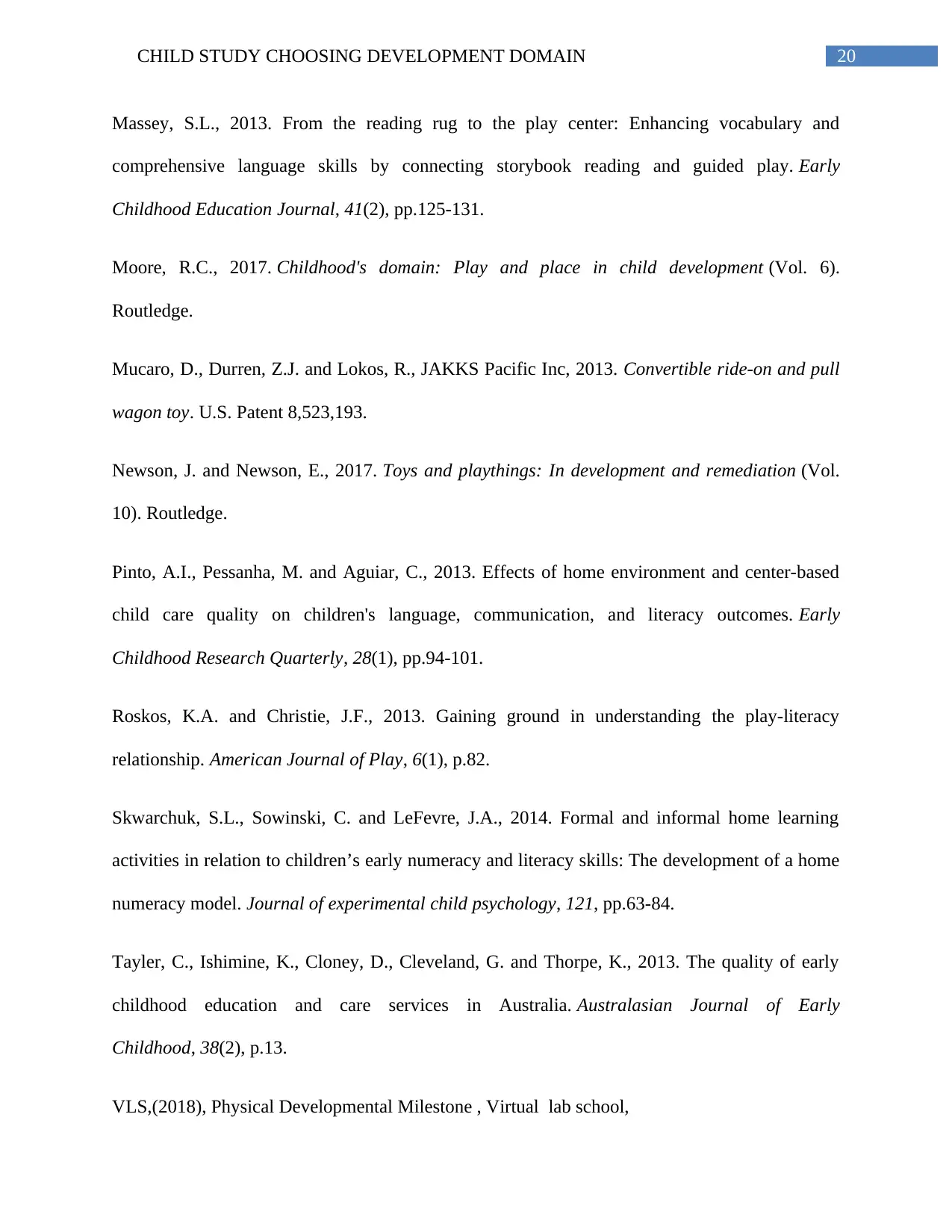
Massey, S.L., 2013. From the reading rug to the play center: Enhancing vocabulary and
comprehensive language skills by connecting storybook reading and guided play. Early
Childhood Education Journal, 41(2), pp.125-131.
Moore, R.C., 2017. Childhood's domain: Play and place in child development (Vol. 6).
Routledge.
Mucaro, D., Durren, Z.J. and Lokos, R., JAKKS Pacific Inc, 2013. Convertible ride-on and pull
wagon toy. U.S. Patent 8,523,193.
Newson, J. and Newson, E., 2017. Toys and playthings: In development and remediation (Vol.
10). Routledge.
Pinto, A.I., Pessanha, M. and Aguiar, C., 2013. Effects of home environment and center-based
child care quality on children's language, communication, and literacy outcomes. Early
Childhood Research Quarterly, 28(1), pp.94-101.
Roskos, K.A. and Christie, J.F., 2013. Gaining ground in understanding the play-literacy
relationship. American Journal of Play, 6(1), p.82.
Skwarchuk, S.L., Sowinski, C. and LeFevre, J.A., 2014. Formal and informal home learning
activities in relation to children’s early numeracy and literacy skills: The development of a home
numeracy model. Journal of experimental child psychology, 121, pp.63-84.
Tayler, C., Ishimine, K., Cloney, D., Cleveland, G. and Thorpe, K., 2013. The quality of early
childhood education and care services in Australia. Australasian Journal of Early
Childhood, 38(2), p.13.
VLS,(2018), Physical Developmental Milestone , Virtual lab school,
⊘ This is a preview!⊘
Do you want full access?
Subscribe today to unlock all pages.

Trusted by 1+ million students worldwide

Wasserman, L.H. and Zambo, D., 2013. Introduction. In Early Childhood and Neuroscience-
Links to Development and Learning (pp. 1-5). Springer, Dordrecht.
Yokota, J. and Teale, W.H., 2014. Picture books and the digital world. The Reading
Teacher, 67(8), pp.577-585.
Related Documents
Your All-in-One AI-Powered Toolkit for Academic Success.
+13062052269
info@desklib.com
Available 24*7 on WhatsApp / Email
![[object Object]](/_next/static/media/star-bottom.7253800d.svg)
© 2024 | Zucol Services PVT LTD | All rights reserved.




